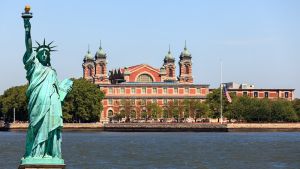 In raw numbers, the American prison population is so large it’s almost hard to grasp. In 1980, the prison population stood at 500,000. Today the United States imprisons about 2.3 million people1 in every 100 adults. If you toss in the number of people currently on probation and parole, the number of people living under some form of correctional control in the United States climbs to a whopping 7.4 milliona number equivalent to the population of Israel.
In raw numbers, the American prison population is so large it’s almost hard to grasp. In 1980, the prison population stood at 500,000. Today the United States imprisons about 2.3 million people1 in every 100 adults. If you toss in the number of people currently on probation and parole, the number of people living under some form of correctional control in the United States climbs to a whopping 7.4 milliona number equivalent to the population of Israel.
Related articles:
The Prison Industrial Complex: Biased, Predatory and Growing
Continue reading this and all our content with a Fair360 subscription.
Gain company-wide access to our premium content including our monthly webinars, Meeting in a Box, career advice, best practices, and video interviews with top executives.MembershipsAlready a member? Sign in.Combining law enforcement, courts and prisons, the U.S. criminal-justice system “consumes $212 billion a year and employs 2.4 million people, more than Wal-Mart and McDonald’s combined,” says Robert Perkinson, an associate professor of American studies at the University of Hawai’i and author of the book “Texas Tough: The Rise of America’s Prison Empire.”
“The prison industrial complex clearly manifests all the inequities that still exist in the U.S.,” say Amanda Petteruti and Nastassia Walsh of the Justice Policy Institute. “The current system magnifies all the ways in which the U.S. fails many of the people who live within its borders.”
The New War, Same as the Old War
Ironically, more than a century ago, “private prisons were a familiar feature of American life, with disastrous consequences,” writes Ken Silverstein, a former Los Angeles Times reporter and current Washington editor for Harper’s Magazine, in his report, “America’s Private Gulag“: “Prisoners were farmed out as slave labor. They were routinely beaten and abused, fed slop and kept in horribly overcrowded cells. Conditions were so wretched that by the end of the nineteenth century private prisons were outlawed in most states.”
But in the 1980s, private prisons like Nashville, Tenn.based Corrections Corporation of America (CCA) made a comeback. The crackdown on undocumented immigrants bears a disturbing resemblance to the political furor that took hold of the nation during the 1980s and 1990s when America’s failed “war on drugs” first took center stage and ultimately herded so many of the country’s young Black and Latino men into America’s ever-expanding prison colossus.
During that time, the prison industrial-complex boom occurred largely on the state level: Politicians campaigned on law and order and made getting “tough on crime” a central part of their political identities, Perkinson says. (Click here to see how past presidents and politicians have contributed to the growth of the prison population.)
The spate of tougher sentencing guidelines that ensued sent state-prison-population growth into overdrive, but as the numbers exploded, so did the tax bill.
As a result of the sheer volume of prisoners and the prison population-growth rate, incarceration is now one of the largest costs borne by taxpayers, consuming one out of every 15 discretionary dollars, according to The Pew Center on the States.
In 2007, total state spending on correctionsincluding bonds and federal contributionstopped $49 billion, up from $12 billion in 1987. By 2011, continued prison growth is expected to cost states an additional $25 billion, the report said.
By the time the U.S. economy slid into a recession in 2000, many states were bursting at the seams with prisoners but lacked the funds and the political support to keep building new prisons. As a result, cash-strapped states, grappling with overcrowding, turned to the private sector for help.
This same dynamic is playing out on the federal level. Congress has nearly doubled annual spending on immigration enforcement in the last five years to $5.7 billion in 2010, with nearly $2.55 billion of that earmarked for detention and removal operations. And with the country once again in the throes of economic turmoil, and the number of immigrant detainees shooting skyward, the private sector, which claims it can build prisons faster and more cheaply and save taxpayer dollars by cutting operational costs, has stepped up to the plate.
In fact, when Damon Hininger, the chief executive officer of CCA, spoke to Wall Street analysts in May, he shared the standard script CCA uses when it lobbies legislators or governors on the pros of privatization: “Why do you want to put $200 million in the ground to build a prison Your voters won’t give you any credit for building the prison. Yes, they want you to be tough on crime, but they’d rather have you build roads, bridges and schools and, in addition, to that we can offer you significant operational cost savings.”
Critics of private prisons argue that this perverse profit motivewhich often overrides basic human rights and needsleads private prisons to cut corners on drug rehabilitation, training, counseling and literacy programs.
“Profits by no means created the machinery of mass incarceration, no more than defense contracts invented war, but the huge profits to be made by incarcerating an ever-growing segment of our population serves the system very well,” says Judith Greene, a policy analyst with Justice Strategies, a nonprofit sentencing-reform advocacy group in New York. “Profits oil the machinery, keep it humming and speed its growth.”
Low Wages, No Training
Over the years, there have been numerous cases where private prisons have been cited, fined or shut down for stinting on food, clothing, education and medical treatment for inmates, including juveniles in detention.
“Money is the top motive and there is an incentive to cut costs,” Black says. “You hear stories of maggots in the food, people with really bad stomach conditions because of the food. A lot of complaints about the food.”
One big area where for-profit prison firms skimp is on labor costs, according to Paul Wright, the founder and editor of “Prison Legal News,” a prison advocacy tabloid. While employees at state-run prisons get union-scale salaries, private-prison guards typically earn a meager $7 to $10 per hour.
“They have low wages and high turnover and very little in the way of benefits or training,” says Wright, who was once a prisoner himself, serving 17 years of a 25-year term for killing a cocaine dealer he was trying to rob. Today, the 43-year-old father is an advocate for prisoner rights and over the years has filed numerous legal challenges against the industry and won. “The private-prison industry is marked by corruption,” he says. “Their premise is they can run prisons cheaper than the government, but taxpayers don’t realize any of those savings. Any savings the private-prison industry obtains is basically profits for their shareholders.”
Advocates say there have been repeated instances when detainees are shuffled around from state to state, away from their families and communities and any legal services that may be able to support them. Often, they don’t have access to working phones to call for legal assistance.
“They are often very isolated,” says Black. “People are moved on average two to three times. We’ve heard of cases of people moved 11 times all over the country, and there are people who had attorneys and their attorneys could not get a change of venue to get their clients back.”
At CCA, however, the reason they give for moving prisoners out of state is pretty straightforward: profits. Hininger told investors that in states such as Hawaii and California, the cost difference between housing an inmate in state versus out of state can be hugean average $40 a day. In California, for example, housing an inmate in the state costs $125 a day. “We are providing beds on the mainland at almost half that,” he said.
Future Looks Good for Private Prisons
Understandably, GEO Group and CCA are optimistic about their industry’s future. During an investor call, GEO Group CEO George Zoley told the audience he believes there is “enough of a growing market share that we can all share in these awards.”
“There is plenty for everybody,” he said.
The recession means federal and state governments have fewer dollars for prison construction, meaning more incarceration has to be outsourced, he said. At the same time, the federal prison system is operating at 137 percent of capacity.
In fact, CCA bragged to investors that its “clients”meaning federal and state governmentsare “notoriously poor planners” when it comes to building new prison beds. And this tends to work to their advantageespecially during a recession when state and federal coffers are tight.
“What we saw coming out of the last recession was a significant reduction in the construction of new prison beds and then when [economic] growth accelerated, they got caught flat-footed and they had to turn to the private sector,” Hininger said during the investor conference. “Even though they may have had a desire to build and manage their own prison beds themselves, they found themselves in a situation where they didn’t have that luxury. And of course, we have the salespeople and lobbyists pitching the benefits of privatization to the governors and legislators, so it’s kind of a unique dynamic. In this environment, where they are not building new beds and they’re being very short-term in their thinking, it creates a situation where they wake up one day and they don’t have beds and will have to turn to the private sector.”


















